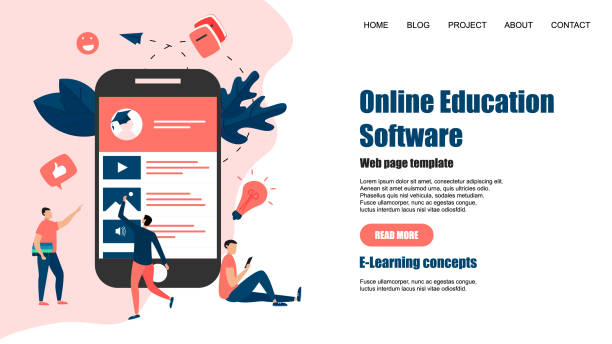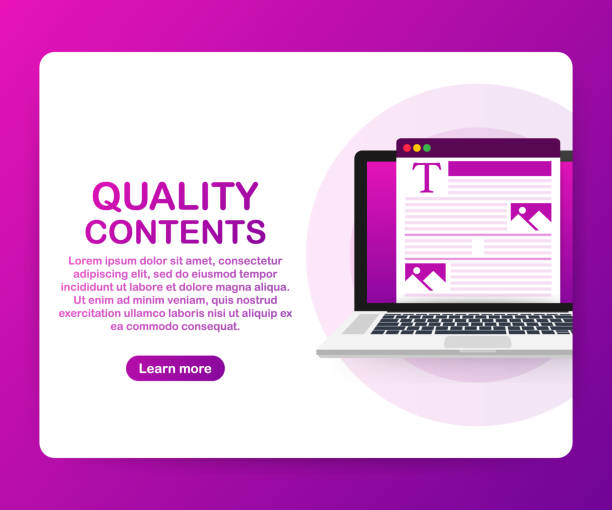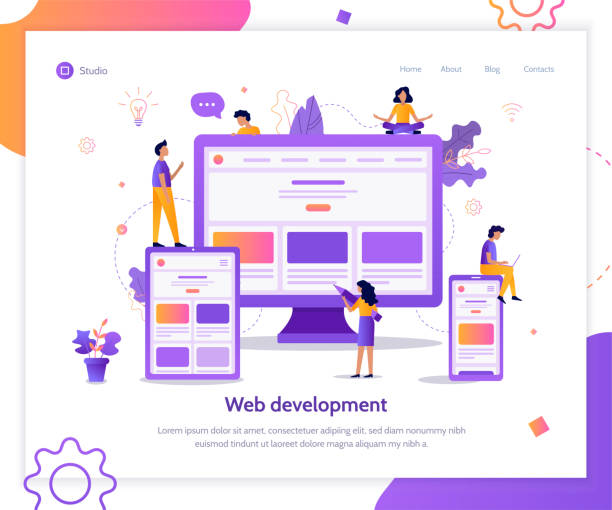Understanding the Fundamentals of Responsive Web Design

In today’s digital world, where users connect to the internet through a variety of devices such as mobile phones, tablets, laptops, and even smartwatches, the importance of having a website that displays correctly on all these platforms has become more prominent than ever.
This is where the concept of #Responsive_Web_Design comes into play.
Responsive Web Design is an approach aimed at creating websites that can automatically adapt their layout and content to the changing screen size of the user’s device.
This approach ensures that the #User_Experience is always optimal, regardless of screen size or resolution.
Before the advent of responsive design, developers had to create separate versions for mobile and desktop, which was costly and difficult to maintain.
With responsive web design, your website is coded only once, and using techniques like Media Queries in CSS and Flexible Grids, it can change its appearance based on the visitor’s device characteristics.
These changes include font size, images, and the overall arrangement of page elements.
The main goal is to provide the best possible experience to the user, whether they are using a small-screen smartphone or a wide monitor.
This approach not only increases #User_Satisfaction but also has a positive impact on your website’s #SEO, as search engines like Google prefer #mobile-friendly websites in their rankings.
In fact, having a #responsive website is no longer an advantage; it’s a necessity for a successful online presence.
This is a fundamental step for any business that wants to make its mark in today’s competitive landscape and expand its reach to a wider audience.
Did you know that 85% of customers check your company’s website before any interaction?
With Rasaweb, build a corporate website that lives up to your reputation.
✅ Increase credibility and customer trust
✅ Attract high-quality leads
⚡ Get a free website design consultation
Why Responsive Design Is Crucial for Your Business?

In the current era, where over half of web traffic originates from mobile devices, the main question isn’t “Should I make my website responsive?” but rather “Why haven’t I done it yet?” Responsive design is not just a trend; it’s a fundamental necessity for the survival and growth of any online business.
The primary reason is the significant improvement in User Experience (UX).
When your website displays correctly on any device, users can easily consume your content without needing to zoom or scroll horizontally, which leads to a reduction in Bounce Rate and an increase in time spent on the site.
This means potential customers spend more time with your brand, increasing the likelihood of converting them into actual customers.
In addition to user experience, responsive design plays a vital role in Search Engine Optimization (SEO).
Google and other search engines prioritize mobile-friendly websites in their mobile search results.
By having a responsive website, you not only achieve a better ranking in mobile searches, but maintaining a single version for all devices is also significantly simpler than managing separate versions.
This translates into savings in development and maintenance time and costs.
Imagine if your website doesn’t load correctly or appears messy on a customer’s smartphone; this negative experience can immediately drive them towards your competitors.
Therefore, a responsive website is a smart investment that yields significant returns in attracting new customers and retaining existing ones. This is particularly important for businesses looking to expand their reach in different markets and attract audiences with varying web browsing habits.
Key Principles and Underlying Technologies in Adaptive Design

Adaptive design, also known as responsive design, is built upon three main pillars: Fluid Grids, Flexible Images, and Media Queries in CSS.
These three elements work together to ensure that your website is displayed dynamically and flawlessly across various devices.
Fluid grids use relative units like percentages for element widths instead of fixed pixel units.
This approach allows elements to adjust their size based on the available screen space, thereby maintaining a consistent website layout across all resolutions.
Flexible images also use CSS to adjust their size to their parent container, preventing them from overflowing the page or appearing excessively large.
This is typically achieved by setting `max-width: 100%;` for images.
However, the main hero in responsive design is Media Queries. Media Queries are parts of CSS that allow you to apply specific styles based on the user’s device characteristics, such as screen width, height, orientation (portrait or landscape), and even resolution.
Using Media Queries, you can define different styles for various Breakpoints.
For example, you can change the menu to a hamburger icon or reduce font sizes for mobile devices.
These technologies combined provide unlimited potential for creating customized user experiences on any device.
A deep understanding of these principles is essential for any web developer looking to enter the field of responsive web design.
SEO Benefits and User Experience Improvement with Responsive Design

One of the most significant reasons businesses are adopting responsive design is its positive impact on SEO (Search Engine Optimization) and user experience improvement.
Google, as the world’s largest search engine, has long emphasized the importance of mobile-friendly websites and has shifted its algorithms to penalize sites with poor mobile user experiences by giving them lower rankings.
By implementing responsive design, you will have only one URL and one source code for your website, which makes the crawling and indexing process much simpler for search engines.
This prevents issues of Duplicate Content that might arise if you had separate versions for mobile and desktop.
Furthermore, a responsive website leads to a reduced Bounce Rate and an increased Dwell Time.
When users encounter an easy and pleasant user interface on any device, they are more inclined to browse more pages and interact more deeply with the content.
These positive signals indicate to search engines that your website is valuable to users, which can help improve your ranking in search results.
Additionally, sharing your content on social networks becomes much easier, as users can simply share the website link, confident that their friends will have a suitable experience no matter which device they open it on.
Ultimately, investing in responsive design is an investment in the future of your online business, as it not only brings user satisfaction but also significantly increases your organic traffic and conversion rates.
How much does losing business leads due to an unprofessional website cost you? Solve this problem forever with professional corporate website design by Rasaweb!
✅ Increase credibility and trust among potential customers
✅ Easier attraction of new business leads
⚡ Get a free consultation now!
Common Challenges and Errors in Implementing Responsive Design

Despite its numerous advantages, implementing responsive design is not without its challenges.
One of the biggest obstacles is Performance Optimization.
Loading high-resolution images on mobile devices with limited bandwidth can lead to very slow loading speeds.
To overcome this, techniques such as “Responsive Images” using attributes like `srcset` and `sizes` or modern image formats like WebP should be employed.
Another challenge is managing large amounts of content.
Over-compressing content for display on a small mobile screen can lead to a poor user experience and difficulty finding information.
Therefore, careful content selection for each breakpoint and ensuring easy access to key information is essential.
Layout complexities can also be problematic.
Some layouts designed for desktop may not be easily adaptable to smaller devices and might require a fundamental structural overhaul.
A lack of proper understanding of Breakpoints and not adopting a “Mobile-First” approach can lead to designs that don’t function correctly on smaller devices.
Testing the website across various devices and different browsers is also a significant challenge.
Ensuring correct functionality across all combinations requires time and appropriate tools.
Many developers overlook testing on physical devices and rely solely on simulators, which may not provide accurate results.
Ultimately, educating the design and development team about responsive design best practices and keeping their knowledge up-to-date is key to success in complex projects.
Popular Tools and Frameworks for Responsive Website Development

To facilitate the process of responsive website development, numerous tools and frameworks are available that simplify developers’ work and accelerate development speed.
One of the most widely used and well-known frameworks is Bootstrap.
Bootstrap, with its comprehensive set of pre-built UI components and a powerful grid system, enables rapid and easy development of responsive websites.
Other frameworks like Foundation and Bulma are also popular options, each with its own features and design philosophy.
The choice of the right framework depends on project requirements and the development team’s preferences.
In addition to frameworks, core CSS technologies like Flexbox and CSS Grid also play a significant role in creating complex and responsive layouts.
Flexbox is excellent for laying out elements in one dimension (row or column), while CSS Grid offers unparalleled power in designing two-dimensional layouts (rows and columns simultaneously).
The combined use of these two provides developers with great flexibility in controlling layouts across various screen sizes.
For front-end developers, browser Developer Tools are also crucial.
These tools enable simulating different devices, testing Media Queries, and Debugging.
Furthermore, tools like PostCSS for processing CSS and automatically generating Vendor Prefixes can be very useful.
Intelligent use of these tools helps development teams create efficient and high-quality websites that perform well on any device.
Testing and Optimizing Responsive Websites

Upon completion of the design and development process, the testing and optimization phase becomes particularly important.
Testing responsive websites means ensuring the correct functionality and optimal display of the website across a wide range of devices and resolutions.
This process includes testing on actual physical devices (mobile, tablet, desktop) as well as using simulators and online testing tools.
Browser developer tools (like Chrome DevTools) offer device simulation capabilities, allowing you to simulate the website at different screen sizes and even with slow network settings.
However, using real devices to check the user experience and feel the actual interactions is essential.
Performance optimization is also an integral part of testing.
Responsive websites must be optimized not only in appearance but also in loading speed.
This optimization includes image compression, CSS and JavaScript optimization, caching, and implementing Lazy Loading for content.
Tools like Google PageSpeed Insights and Lighthouse can provide detailed reports on your website’s performance and offer suggestions for improvement.
Furthermore, Accessibility Testing is crucial to ensure that the website is usable for users with special needs.
A successful responsive website is one that is not only beautiful and functional but also performs optimally and loads quickly under all conditions. This process is a continuous cycle of testing, analysis, and improvement, essential for maintaining the quality and competitiveness of your website.
Future Trends in Responsive Website Design

The world of the web is constantly evolving, and responsive website design is no exception.
New trends and emerging technologies are shaping the future of web design.
One of the most important upcoming trends is an increased focus on Progressive Web Apps (PWAs).
PWAs offer a combination of the best features of web and mobile applications, including offline functionality, sending notifications, and installation on the device’s home screen, which significantly improves the user experience.
This approach means providing a seamless and fast experience, even in poor internet connectivity conditions.
Another trend is the use of Artificial Intelligence (AI) and Machine Learning in the design and development process.
AI tools can analyze user data, suggest automatic optimizations in layout and content, and even automatically apply minor changes to improve the user experience on different devices.
Designing for Dark Mode, which is both visually appealing and reduces battery consumption, is also becoming a standard that web designers should consider.
Furthermore, responsive website design in the future will move further towards personalization and adaptability to the specific needs of each user. With the expansion of the Internet of Things (IoT) and more diverse smart devices, the need for designs that go beyond mobile and desktop and display correctly on devices like smartwatches, car displays, and even home appliances is increasing.
These developments indicate that the concept of web responsiveness has always been, and will continue to be, expanding and evolving.
Tired of losing customers due to poor e-commerce website design? With Rasaweb, solve this problem forever!
✅ Increase sales and conversion rates from visitors to customers
✅ Smooth and engaging user experience for your customers⚡ Get a free consultation
Step-by-Step to Implementing Successful Responsive Design

Implementing a successful responsive design requires careful planning and systematic execution of steps.
The first step is planning and strategy.
First and foremost, identify your target audience and the devices they predominantly use to access your website.
This information will help you determine logical Breakpoints.
A “Mobile-First” approach is highly recommended; that is, start designing and developing for the smallest screen size, and then gradually add features and details for larger devices.
This approach ensures that the core user experience is maintained across all devices and fast loading on mobile is guaranteed.
The second step is user interface design and development.
At this stage, you should use Fluid Grids and responsive images.
The use of Scalable Fonts is also important.
In the coding phase, correctly implement Media Queries so that styles are properly applied for each screen size.
Using frameworks like Bootstrap can significantly speed up development. The third step is continuous testing and optimization.
As previously discussed, testing on real devices and different browsers is essential.
Monitoring website performance with tools like Google PageSpeed Insights and Core Web Vitals is also crucial to ensure website loading speed and responsiveness.
This process is a continuous cycle, and given the constant changes in technology and user habits, updating and maintaining a responsive website should be done regularly.
By following these steps, you can create a powerful and future-proof website that shines on any platform.
A Comprehensive Look at the Future of Web with Responsive Design

As discussed in this article, responsive design is not merely a choice but an undeniable necessity in the modern web landscape.
This approach goes beyond mere visual aesthetics; it serves as a foundation for providing a seamless user experience, improving SEO, and ultimately ensuring the success of businesses in the digital world.
Since its introduction by Ethan Marcotte in 2010, responsive design rapidly became an industry standard and has evolved over the years with technological advancements and the emergence of new devices.
Today, it no longer solely means adapting to screen size but also includes performance optimization, accessibility, and even content personalization for each user.
The future of the web will be increasingly diverse and distributed, with new smart devices and platforms constantly being introduced.
In such an environment, a website’s ability to automatically adapt to any environment from which it is accessed will be more critical than ever.
Responsive website design allows businesses to reach all their audiences, regardless of the device they use.
This approach is particularly important in emerging markets where internet access is predominantly via mobile devices.
Therefore, investing in knowledge and skills related to responsive design is not just a tactical move for today, but a long-term strategy for a powerful and sustainable presence in the digital future.
By embracing this philosophy, you can ensure that your website always remains at the cutting edge of technology and provides the best possible experience for your users.
Frequently Asked Questions
| Question | Answer |
|---|---|
| What is Responsive Web Design? | An approach to web design aimed at creating websites that can automatically adapt to the screen size and device of the user (computer, tablet, mobile) and provide the best user experience. |
| Why is Responsive Design important? | Its importance has increased due to the growing variety of devices people use to access the internet. This design improves user experience, boosts search engine rankings (SEO), and reduces maintenance costs. |
| How is Responsive Design implemented? | By using CSS techniques such as Media Queries, which allow you to change styles based on device characteristics (like screen width), Fluid Grids, and Flexible Images. |
| What are the key principles of Responsive Design? | The three main principles are: Fluid Grids (using relative units like percentages instead of pixels for widths), Flexible Images (adapting image sizes to available space), and Media Queries (applying different styles based on screen characteristics). |
| What are the benefits of having a responsive website? | Providing a unified user experience across all devices, improving SEO, increasing user time on site, reducing bounce rate, and simplifying site management and updates (only one codebase). |
And other services of Rasaweb Advertising Agency in the field of advertising
Smart UI/UX: A creative platform for improving SEO ranking by customizing user experience.
Smart Website Development: A professional solution for customer acquisition focusing on real data utilization.
Smart Data Analysis: A fast and efficient solution for increasing sales focusing on attractive UI design.
Smart Content Strategy: A specialized service for increasing sales based on intelligent data analysis.
Smart Sales Automation: An effective tool for increasing sales with the help of Google Ads management.
And over hundreds of other services in the field of online advertising, advertising consulting, and organizational solutions
Internet Advertising | Advertising Strategy | Advertorials
Resources
What is Responsive Design?Importance of Responsive Websites for BusinessesBest Practices for Responsive DesignHow to Create a Responsive Website?
? Are you ready to transform your business in the digital world? Rasaweb Afarin Digital Marketing Agency, by providing comprehensive and innovative solutions, including fast website design and professional optimization, paves your way to success. With us, have a powerful and lasting presence in the online space.
📍 Tehran, Mirdamad Street, next to Bank Markazi, Southern Kazeroon Alley, Ramin Alley No. 6


